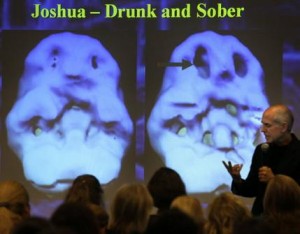West Palm’s Hanley Center Hopes Brain Scanner can Tailor Addiction Treatment
Posted By admin on
Dr. Daniel Amen shows brain scans of a patient both drunk and sober during a talk about scans and their use in addiction treatment at a seminar at the Hanley Center Tuesday morning, September 14, 2010. Starting this month, every new Hanley Center patient will have a SPECT scan taken of their addicted brain. The SPECT images, which reveal blood flow to the brain, will show patients their substance-abuse damaged brains, help Hanley Center design more effective treatment, and identify other brain-based conditions that contribute to addiction,such as depression and brain trauma.
The image has been seared into the memory of an entire generation: an egg frying in a sizzling hot pan.
“This is your brain on drugs. Any questions?”
Well, the people who treat drug and alcohol addiction at Hanley Center in West Palm Beach have bought themselves a bigger and more expensive – nearly $500,000 – camera, and they’re betting the image it makes will not only deter people from using drugs but help hundreds of addicts get better treatment.
It’s called a SPECT scan.
While it is not a technology new to medicine, it is certainly a new and not-yet-common tool in the treatment of addiction.
“We are definitely a pioneer in this,” said Barbara Krantz, Hanley’s CEO and medical director of research. “Addiction medicine is finally catching up with technology.”
Hanley is teaming up with renowned brain imaging expert Dr. Daniel Amen to put the pictures to use.
And in these pictures, the brain of an addict looks less like a fried egg and more like Swiss cheese.
This is probably the SPECT scan’s most agreed-upon benefit.
People who can see that an addict’s brain is physically different – riddled with holes where blood flow should be or lit up like a fireball with an overabundance of activity – are more likely to believe they have a problem or to recognize that addiction isn’t simply an attitude.
And what a deterrent.
Amen, speaking to a group of about 200 health care professionals at Hanley Tuesday, boasts that he shows his kids the Swiss cheese “your brain on drugs” images in hopes they’ll steer clear.
He said a judge in Cleveland buys poster images “by the hundreds” for the same purpose.
Amen and Krantz believe the scans will be even more valuable in tailoring recovery programs for individuals.
How extensively the scans can be used in diagnosing psychiatric, behavioral or mood disorders that may underlie or accompany addiction continues to be a matter of discussion in the medical community.
The problem?
For one: Not all addicts’ brains look alike. Some addicts’ brains are more resilient and healthy looking than others.
And some people who are not addicts have imperfect scans for other reasons, said Marisa Silveri, an assistant professor of psychiatry at Harvard Medical School who specializes in neuroimaging research.
Still, she describes herself as optimistic that down the road such efforts will lead to better treatments, yet cautious about the current rise in the use of SPECT imaging for personalized diagnosis.
For now, what she wants are more empirically based SPECT studies that compare the brains of control groups to those of addicted ones.
That evidence is something Amen’s few ardent critics say he lacks.
The director of the National Institute of Mental Health, Dr. Thomas Insel, is on record as saying neuroimaging is the future in psychiatric treatment.
The institute’s website notes neuroimaging can be a useful tool to find the right diagnosis for mood and behavioral problems.
And brain imaging – not just SPECT scans, but PET scans, which are more detailed, and MRIs which don’t require radioactive material coursing through veins – are responsible for strides in the understanding of addiction.
Amen, who operates four clinics from his home offices in California and boasts the world’s largest collection of nearly 60,000 SPECT scans, said he has seen the benefits firsthand.
For example, he said, he might be confronted by two alcoholics. One can’t stop thinking about his drug. He’s controlled. Obsessed.
The other is simply impulsive. Doesn’t think a lot about it, but when presented with it can’t refuse.
A brain scan, Amen said, would give insight into how each brain functions and could lead to entirely different treatment approaches.
Hanley plans for everyone coming for treatment to be scanned initially as part of the program cost.
They can have a follow up after they’re in recovery, for $1,200 – a fee that some insurance will cover, Krantz said. The machine will also be available to the public, she said.
Finally, the scans will be part of an ongoing research project that Hanley is coordinating with Scripps Florida’s Paul Kenny. They hope to find biomarkers that predict which patients are most likely to relapse.
Staff researcher Niels Heimeriks contributed to this story.
Source: Palm Beach Post

Comments